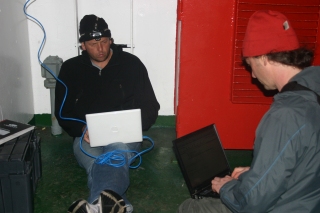I-TASC Antarctic expedition 2006-07 – aboard SA Agulhas icebreaker
We are at the footsteps of the continent. The walls of ice now are gigantic. Just four days ago a few meters of ice would be photographed at least a dozen times by the crew and passengers by the time it had floated down the length of the boat. Now we are spoilt for ice. Huge motionless icebergs surround us with sheer cliffs falling to the sea. Some have the appearance of being on fire as the strong winds whip the loose ice off the windward cliff edges in a grey smoky haze. Icebergs on fire off the shoulders of Neumayer. This afternoon we slowly crawled by a piece of ice the size of Waiheke Island. It is by no means the biggest iceberg here, but distance and size is hard to judge when measuring white cliffs against a white sea and light grey sky. We can only judge the size of the ice that comes close to the ship and these are impressive. I wonder if it was these chunks of the ice shelf that Cook referred to as ice islands.
It looks like we may have time to become quite familiar with these particular icebergs. Round and round we go at a crawl… 11 miles from Neumayer but there is no opening in the ice that we can go through. The sea is too deep to anchor, and the captain judges it better to be under our own power than to drift. So we crawl round and round in huge circles. We don’t know how long it will take; there has been mention that we could spend Christmas on the boat. No one wants this. The entire journey we have been amazed at how lucky we have been with the weather. We have faced no storms, and the pack ice was cleared early by swells only a few weeks before we arrived. By all counts, we arrived here at least 2 days ahead of schedule. Now it seems our 4500km journey will be stalled just 11 miles from home. As a result, I think everyone has gone a smidgen stir crazy. The bird counter looked a bit deranged as he has been sitting upstairs counting birds for 10 days to calculate approximate bird populations through the areas we have travelled. But now he is surrounded by birds and can’t count them, otherwise the results would be skewed as we are circling the same area.
The captain looks bored. I saw the ships doctor cleaning the keyboard of the library’s PC, muttering something about possible diseases one could catch through unhygienic computing. First Born has gone to sleep early (it’s 1920) to dream of trees. Outside my cabin door, Bob Marley is reassuring everyone that everything will be alright and I can hear the overly dramatic slapping of dominoes from the ship’s bar at the end of the corridor. In short, there is nothing to be done. The scientists calculate the possible research days they may lose, and the ship’s crew paint unnecessarily while they wait for the well-paid overtime hours they will work once docked. Everyone wants to get to shore.
In the meantime the I-TASC crew devises strategies to inform people of what we are doing and argues about whether the website jpg should show the feet of Ladimur or not. I think it would do us all good to put our feet on firm ground…
 Today we slept late and worked only a little together as the I-TASC crew. It was a day off as it is Sunday. I passed the ship’s bar and TV lounge before lunch to see a small group of 7 or 8 people using the space as a makeshift church. During the afternoon, I read more about Shackleton’s amazing journey in his own words. Unbelievable. They seemed to survive for almost 18 months with little more than we would throw away in a week. I learned some Dutch a bit later then met the crew for dinner. After dinner, we met with Pierre and tried getting connected to the net via a BGAN terminal. We squatted on a high deck and tried to find the satellite in the dark, windy and cold night. We soon had a good connection and we were able to put up the Interpolar and I-TASC websites easily.
Today we slept late and worked only a little together as the I-TASC crew. It was a day off as it is Sunday. I passed the ship’s bar and TV lounge before lunch to see a small group of 7 or 8 people using the space as a makeshift church. During the afternoon, I read more about Shackleton’s amazing journey in his own words. Unbelievable. They seemed to survive for almost 18 months with little more than we would throw away in a week. I learned some Dutch a bit later then met the crew for dinner. After dinner, we met with Pierre and tried getting connected to the net via a BGAN terminal. We squatted on a high deck and tried to find the satellite in the dark, windy and cold night. We soon had a good connection and we were able to put up the Interpolar and I-TASC websites easily.